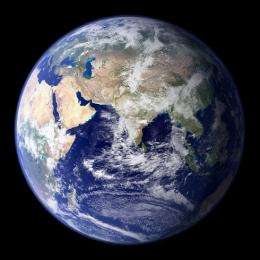Using satellite data to decode disease origins

Uncovering the origin of illness is like finding a needle in a haystack, but that search is getting easier with the help of powerful tools like genetic analysis and satellite data.
In Katmandu, Nepal, where outbreaks of typhoid are common, researchers used tiny genetic mutations in the makeup of the pathogen to gain a better understanding of where it began and how it spread.
"Typhoid is completely eradicable," said Stephen Baker, head of intestinal infections at the Oxford University clinical research unit in Ho Chi Minh City, Vietnam and the lead author of the new research published last week in the journal Open Biology. "We are not only highlighting people to the fact that typhoid is still prominent, but we're understanding more about how it's transmitted."
Baker's team went to each infected person's house and mapped the location using GPS. Then they analyzed the genetic material in the typhoid bacteria from each patient. Like other diseases, typhoid evolves as it spreads, so the researchers used the combination of DNA mapping and geographic mapping to see exactly how the disease moved through the population.
Baker said it took three years -- and a lot of dedication -- to collect all the data, both genetic and locational.
"People don't have addresses in Katmandu," Baker said.
When the team analyzed all the data, they found something that bucked conventional wisdom.
"The dogma in our field is that where there are more people, there will also be more cases of typhoid -- and that wasn't the case," Baker said.
Instead, the outbreaks of typhoid were clustered around specific locations, which didn't match up with population density. Even more surprising, strains of typhoid were often different in people living in the same household -- meaning that the illness was not being transmitted from person to person but rather through water sources, where multiple strains may be present. So the woman known as Typhoid Mary, a cook in New York believed to have spread the disease to dozens in the early twentieth century, may not have been entirely at fault.
Typhoid is spread when water gets contaminated with fecal bacteria, and the Centers for Disease Control and Prevention estimates it sickens 21.5 million people per year around the globe. Baker said that using tools like GPS and genetic sequencing shows the need for better sanitary conditions and clean water, alongside vaccines -- which prevent person-to-person transmission.
"Vaccines are only part of the answer," Baker said.
The study showed that two groups of people were particularly at risk for getting sick: people living near to water spouts -- a main source of water -- and people living at a lower elevation, presumably because dirty water would flow downward to them.
Other experts see the promise in new tools to understand disease outbreaks.
"With better information, you can predict where certain strains may be occurring, and also identify geographic regions where certain agents are likely to be more effective," said Ward Wheeler, curator in the Division of Invertebrate Zoology at the American Museum of Natural History in New York City, who helped create a web application that tracks the evolution of pathogens on a map. "That really could be a big help in dealing with outbreaks in public health."
New tools aren't just for prediction, either. They can help researchers see connections that wouldn't otherwise be apparent.
"Geospatial technologies allow scientists to put diverse information in a common context to inspire and test hypotheses and see patterns that are not apparent in two-dimensional graphs," said Daniel Janies, associate professor at Ohio State University, who also works on maps that combine genetic and geographical information.
Baker said that typhoid, like cholera, tends to be overlooked by western countries, but it is still a killer in many places.
"There a lack of understanding of the overall incidence and of the long-term implications of typhoid," Baker said.
New technological tools may help fill in some of the gaps.
More information: Paper doi:10.1098/rsob.110008


















